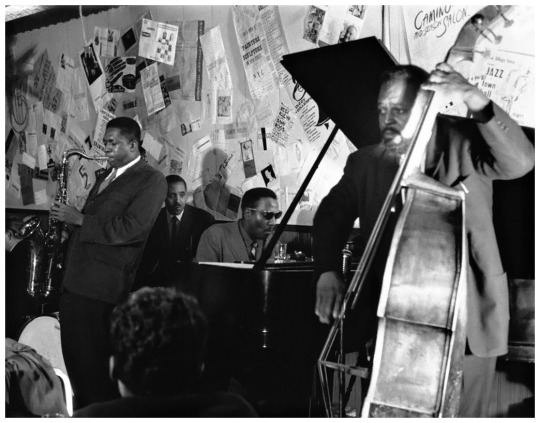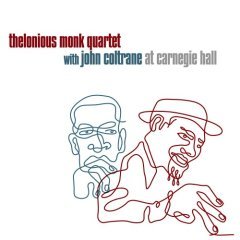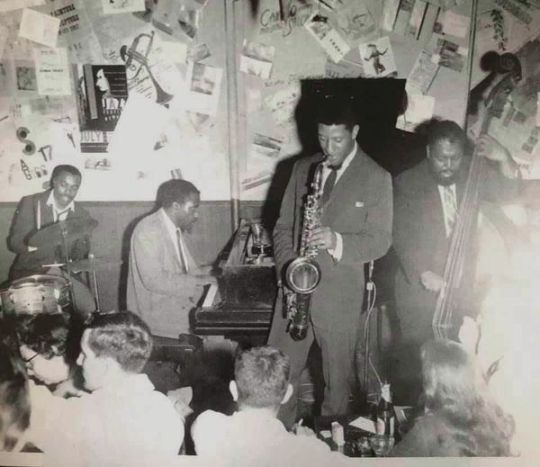#ahmed abdul-malik
Text

John Coltrane with Shadow Wilson, Thelonious Monk and Ahmed Abdul-Malik, The Five-Spot, New York, NY 1957
Photo Don Schlitten.
#jazz#The Five-Spot#1957#Don Schlitten#John Coltrane#Shadow Wilson#Thelonious Monk#Ahmed Abdul-Malik
312 notes
·
View notes
Text
youtube
African Bossa Nova - Ahmed Abdul-Malik (Sounds Of Africa, 1963)
#Soul#Soul Music#Soul Music Songs#Music#Music Songs#Ahmed Abdul-Malik#Instrumental#Soul Jazz#RCA Victor#New Jazz#1963#Sounds Of Africa#Jazz#African Bossa Nova#Youtube
42 notes
·
View notes
Text

John Coltrane, Shadow Wilson, Thelonious Monk and Ahmed Abdul-Malik at the Five Spot Café, NYC 1957
#john coltrane#thelonious monk#shadow wilson#ahmed abdul-malik#jazz#on stage#five spot cafe#1950s#1957#new york city
123 notes
·
View notes
Text
Thelonious Monk Quartet with John Coltrane at Carnegie Hall: A Jazz Masterpiece Rediscovered
Introduction:
There are serendipitous moments in the annals of jazz history when it seems as though the musical gods are smiling at us. One such incident happened in 2005 when Larry Appelbaum, the Library of Congress’s supervisor of the recording lab, happened to find a tape that would turn out to be a surprise. This tape, which dates to November 29, 1957, documents a historic occasion: the…

View On WordPress
#Ahmed Abdul-Malik#Billie Holiday#Chet Baker#Classic Albums#Dizzy Gillespie#Jazz History#John Coltrane#Larry Appelbaum#Ray Charles#Shadow Wilson#Sonny Rollins#Thanksgiving Jazz#Thelonious Monk#Thelonious Monk Quartet#Thelonious Monk Quartet with John Coltrane at Carnegie Hall
2 notes
·
View notes
Audio
Listen to: African Bossa Nova [excerpt] by أحمد [Ahmed]
0 notes
Text
HELP PALESTINIANS
#free palestine#stop the genocide#free gaza#please help#palestine#from the river to the sea palestine will be free#emergency#help needed#help now#petition#save rafah#free rafah#rafah#palestinian families#save palestine#justice for palestine#jerusalem#gaza#tel aviv#israel is committing genocide#israel is a terrorist state#ramallah#gaza genocide#palestinian resistance#ramadan#zakat#anti zionisim#the world stands with palestine#urgent
12 notes
·
View notes
Text
youtube
Thelonious Monk Quartet with John Coltrane Epistrophy, Live at Carnegie Hall 1957
Thelonious Monk – piano
John Coltrane – tenor saxophone
Ahmed Abdul-Malik – bass
Shadow Wilson – drums
33 notes
·
View notes
Text
Hamas Founder Ahmed Yassin In 1999: Based On The Quran, There Will Be No Israel By 2027
Hizbullah Sec-Gen Nasrallah: Pro-Palestinian Demonstrations In The West Are Highly Important;
Hizbullah MP: America Is Behind Every War In The World;
British Historian Dr. Osman Latiff In Podcast Episode Titled 'Don't Let Israelis Hijack The Holocaust'
Children At Yemeni-Houthi Rally To Support Gaza: Abdul-Malik Badreddine Al-Houthi, We Are Your Soldiers, Use Us To Strike The Necks Of The Infidels! Jihad - Victory Or Martyrdom!;
Dozens Of Yemenis Flogged And Stoned By Houthis
The Hadith Of The Stones And The Trees - About Muslims Killing The Jews Ahead Of The End of Days - In The Hamas Charter;
IRGC Qods Force Commander On Iran's 'Harsh Vengeance' Against Its Enemies And The Enemies Of The Muslims
#Hamas#secular-jew#israel#jewish#judaism#israeli#jerusalem#diaspora#secular jew#secularjew#islam#yassin#Ahmed Yassin#Hamas is Isis#terrorism#terrorist#no ceasefire#Palestinian#Gazan#gaza#samalia#judea
8 notes
·
View notes
Text




On 26 October, the Palestinian Ministry of Health released the list of names of Palestinians killed since 7 October. Among them, from the al-Kahlot family, are:
Jihad Muhammad Hussein (73) and his daughter, Khawlah Jihad Muhammad (41);
Suhail Hassan Ahmed (65) and his children Hassan Suhail Hassan (34), Haya Suhail Hassan (31), Ahmed Suhail Hassan (28), Mahmud Suhail Hassan (26), Hadi Suhail Hassan (25), and Abdul Rahman Suhail Hassan (19);
Ghada Abdel Rahman Younis (55);
Shakir Marzouk Shakir (48), his wife, and their children Raghad Shakir Marzouk (10), Malik Shakir Marzouk (9), Abdullah Shakir Marzouk (8), and Adam Shakir Marzouk (4);
Wail Hassan Mahmoud (46), his wife Amna, and their twin daughters, Rahaf and Rafif Wail Hassan;
Hind Abdelkarim Abdel Rahim (42);
Fatima Khamis Abid (42);
Iffat Zein Rabah (39);
Muhammad Mahir Abdel Rahman (39) and his son Zayn al-Din Muhammad Mahir (2);
‘Isam Mahmoud Muhammad (38), his wife, and their children Nur 'Isam Mahmoud (11), Muhammad 'Isam Mahmoud (5), and Amal 'Isam Mahmoud (13);
Wafaa Yusuf Ali (38);
Abdelfattah Ezzo Abdelfattah (33), a banker and father, remembered as an "ambitious young man since his childhood, loving, courteous, and generous, always willing to serve friends, relatives, and anyone he could;"
Ahmed Maher Abdel Rahman (29);
Rawan Sami Yusuf (29);
Yusuf Rami Abdel Rahim (11);
Sarah Hassan Marzouk (11) and her siblings Hazim Hassan Marzouk (8) and Sally Hassan Marzouk (2);
Omar Bilal Bashir (6);
Yusuf Nael Ismail (6);
Muhammad Bahaa el-Din Awad (4);
Siham Ibrahim Abdelkarim (2);
Muhammad Ahmed Suhail (2);

Halima Abdelkarim, an artist and facilitator with the Palestinian Ministry of Culture, described as having a "unique perspective on life reflected in her artwork";
Majed Abdel Wahab Bakr (6);
Safiyyah Ibrahim Abdelkader (58);
Malik Hamdi Abdullah (19);
and Jana Mahmoud Ahmed (8).
You can read more about the human lives lost in Palestine on the Martyrs of Gaza Twitter account and on my blog.
5 notes
·
View notes
Audio
Live’ at the Village Vanguard , was Coltrane’s first official ‘live’ album... This set documents all four-night stand by John Coltrane (sax) and his quintet at the Village Vanguard in New York City, November 1/5/1961. Coltrane is accompanied by an all-star ensemble of... Eric Dolphy (alto sax/bass clarinet), Garvin Bushell (oboe/contrabassoon), Ahmed Abdul-Malik (oud), McCoy Tyner (piano), Jimmy Garrison (bass), Reggie Workman (bass), Elvin Jones (drums), and Roy Haynes (drums).
(via ▶︎ Chasin' Another Trane... Live at The Village Vanguard | John Coltrane | Moochin' About)
40 notes
·
View notes
Text
youtube
Wakida Hena - Ahmed Abdul-Malik (Sounds Of Africa, 1963)
#Soul#Soul Music#Soul Music Songs#Music#Music Songs#Ahmed Abdul-Malik#Wakida Hena#Instrumental#Soul Jazz#RCA Victor#New Jazz#1963#Sounds Of Africa#Jazz#Flute#Youtube
4 notes
·
View notes
Text
The Sorcerers/The Outer World Jazz Ensemble - split single from ATA Records, Ethio-jazz from Leeds
ATA Records are proud to announce this new double A-side from The Sorcerers featuring, on the flip, the first release by The Outer Worlds Jazz Ensemble.
Exit Athens marks the start of a new era for The Sorcerers. Continuing their investigations of Ethio-Jazz and 60s and 70s European library music, the group is now formed around Joost Hendrickx (Kefaya, Shatner's Bassoon, Abstract Orchestra), Richard Ormrod (saxes, flute & keys) and ATA label head, bassist Neil Innes. Exit Athens features a driving funk engine room combined with exotic percussion, vintage keyboards, and the classic Addis Ababa combination of vibes, flute and oh-so-solid horns. Channelling the maximal, saturated aesthetic of 70s exploitation thrillers, The Sorcerers hope this sound will have you on the edge of your seat throughout!
On the AA side, Beg, Borrow, Play marks the debut of The Outer Worlds Jazz Ensemble. The first in an ongoing series of 45s and LP issues, each Outer Worlds release will feature the immaculate grooves of the hard-working, unsung sidemen of the Leeds Funk, Latin and Ethio/Afrobeat scenes. The Outer Worlds series was conceived to feature visiting soloists who have made a beeline to ATA in search of a specific setting for their material.
Beg, Borrow, Play kicks this off with ATA veteran Chip Wickham on baritone sax, and a slice of jazz exotica that owes as much to New Orleans Street Beat as to the Eastern moods of artists like Yusef Lateef and Ahmed Abdul-Malik. The result is loose and limber, with horns reminiscent of classic Art Ensemble of Chicago, and will appeal to fans of contemporary Afro-Futurist fusions as much as to devotees of the more esoteric side of 60s Blue Note, or early Hi-Life.
#Bandcamp#ata records#the sorcerers#outer worlds jazz ensemble#leeds#chip wickham#2023#jazz#ethio-jazz
2 notes
·
View notes
Photo

Ahmed Abdul-Malik with Thelonious Monk, Sonny Rollins, and Roy Haynes at the Five Spot Cafe, New York City, late 1950s.
7 notes
·
View notes
Photo

John Coltrane, Shadow Wilson, Thelonious Monk, & Ahmed Abdul-Malik, Five Spot Café, NYC, 1957
Photo: Don Schlitten
21 notes
·
View notes
Text
Thelonious Monk and John Coltrane
Certain combinations of men have been leaving marks on music called jazz since its beginning. Some formed a lifetime association; others were together only for a brief period. Some actively shaped the course of jazz; others affected it more osmotically. All have had one thing in common; they produced music of lasting value.
One historic teaming was that of Thelonious Monk and John Coltrane at New York's Five Spot Cafe, beginning in the summer of 1957. Although the group remained together for only a half-year, those of us who heard it will never forget the experience. There were some weeks when I was at the Five Spot two and three times, staying most of the night even when I intended just to catch a set or two. The music was simultaneously kinetic and hypnotic. J.J. Johnson has compared it to the mid-Forties union of Charlie Parker and Dizzy Gillespie. "Since Charlie Parker, the most electrifying sound that I've heard in contemporary jazz was Coltrane playing with Monk at the Five Spot... It was incredible, like Diz and Bird," Jay said.
Monk and Coltrane complemented each other perfectly. The results of this successful musical alliance were beneficial to both. In this setting, Monk began to receive the brunt of a long-overdue recognition. On the other hand, Coltrane's talent, set in such fertile environment, bloomed like a hibiscus. 'Trane's comments in a Down Beat article [September 29, 1960] clearly describe how he reveres Monk. "Working with Monk brought me close to a musical architect of the highest order. I felt I learned from him in every way through the senses, theoretically, technically. I would talk to Monk about musical problems and he would sit at the piano and show me the answers by playing them. I could watch him play and find out the things I wanted to know. Also, I could see a lot of things that I didn't know about at all," he stated.
Later in the piece, 'Trane added: "I think Monk is one of the true greats of all time. He's a real musical thinker- -there's not many like him. I feel myself fortunate to have had the opportunity to work with him. If a guy needs a little spark, a boost, he can just be around Monk, and Monk will give it to him." Monk certainly brought 'Trane out beautifully. It was in this period that John began to experiment with what at the time I called "sheets of sound." Actually, he was thinking in groups of notes rather than one note at a time. Monk's practice of "laying out" allowed 'Trane to "stroll" against the pulse of bass and drums and really develop this playing attitude on his own. Pointed examples of this can be heard here in "Trinkle, Tinkle" and "Nutty."
Toward the latter part of '57, Ahmed Abdul-Malik took over Wilbur Ware's bass post. But in the three selections here, the original quartet is intact. Ware and Monk had played together on one of Thelonious's visits to Chicago, and when Wilbur migrated to New York he was Monk's choice for the group. I find no coincidence in Martin William's statement that Ware ... has something of the same basic interest in displacement of accents and rhythmic shiftings and in unusual sequence of harmonics that one hears in Thelonious Monk." Listen to Ware's solo on "Trinkle, Tinkle" for evidence.
Shadow Wilson was about two and a half months short of his 40th birthday when he died on July 11, 1959, and another of jazz's Coltrane (left), Monk tremendous talents had left the scene far too early. A great big-band drummer, Wilson had performed most notably with Count Basie and Woody Herman (the Herman band once voted for him en masse, when a replacement was needed for Dave Tough), but he was equally capable of ministering to the specific needs of a small group. His post. But in the three selections here, the original quartet is intact. Ware and Monk had played together on one of Thelonious's visits to Chicago, and when Wilbur migrated to New York he was Monk's choice for the group. I find no coincidence in Martin William's statement that Ware ... has something of the same basic interest in displacement of accents and rhythmic shiftings and in unusual sequence of harmonics that one hears in Thelonious Monk." Listen to Ware's solo on "Trinkle, Tinkle" for evidence.
Shadow Wilson was about two and a half months short of his 40th birthday when he died on July 11, 1959, and another of jazz's Coltrane (left), Monk tremendous talents had left the scene far too early. A great big-band drummer, Wilson had performed most notably with Count Basie and Woody Herman (the Herman band once voted for him en masse, when a replacement was needed for Dave Tough), but he was equally capable of ministering to the specific needs of a small group. His aware accenting of "Trinkle, Tinkle" shows how well he understood Monk's music and his nourishing beat, here and on "Nutty," is a rare combination of swing and taste. Don Schlittenk and Wilson on the bandstand at the Five Spot.
As we were to regret the passing of Shadow Wilson in 1959, many of us, in a different way, bemoaned the demise of that particular Monk quartet at the end of 1957. The fact that the group had presumably not been recorded was especially distressing. Now we have three gems to hold in our hands and enjoy, facet by facet. All are Monk compositions, and it is interesting to note that they were originally recorded in trio contexts by him: "Ruby, My Dear," which I once described as "sentiment without sentimentality," was first done around 1948, although it was probably written several years before. Coltrane states its tender beauty with a tone that helps transmit the sadness pervading the melody. Monk's half-chorus says more than most pianists do in a whole LP.
"Trinkle, Tinkle" originated in 1952. There is some fascinating interplay between piano and tenor in 'Trane's first improvised chorus. This is followed by some fantastic Coltrane in the "strolling" section. If you close your eyes, it is easy to imagine a cello or viola being bowed by a demonic force of vivid imagination. Thelonious rephrases his own melody in his inimitable manner before Ware's solo.
"Nutty," written in 1954, swings relaxed in an optimistic mood. Coltrane spins out his amazingly long-lined offerings, handing them together with shorter bursts and an overall personal sense of logic. Monk again divides and subdivides his own theme, paraphrasing from one of his earlier speeches, as it were.
To round out the album, three alternate masters from previously released Monk sessions are included. "Off Minor" and "Epistrophy" were heard on Monk's Music (Riverside RLP 242). It is stimulating to compare the different versions and how the solos vary and coincide from take to take. "Off Minor" has solos by Hawkins, Copeland, and Monk, but the bits by Ware and Blakey are not as developed as on the original issue. "Epistrophy," in the original version, featured all the horns of the septet and Monk. Here, only Coltrane and Copeland are heard in solo.
The first "Functional" is on Thelonious Himself (Riverside RLP 235). This version is as different in individual idea and, at the same time, close in spirit to the other, as two takes can be. It almost deserves a title of its own. I only wish I had two turntables. I think the two "Functional’s might make a wild duet for four Monk hands.
But, as intriguing as these alternate masters are, the main attraction here is the unearthing of the quartet tracks. These are milestones in jazz history and important to every serious listener.
Steve Lacy, the soprano saxophonist who worked with Monk for sixteen weeks in 1960, has said of Monk's music: "Monk has got his own poetry and you've got to get the fragrance of it."
It is obvious that in 1957, Coltrane was doing some deep breathing.
Ira Gitler
5 notes
·
View notes